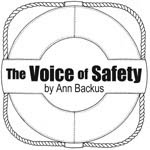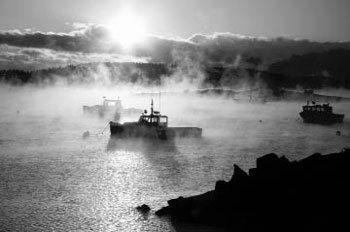Summer Fog, Beautiful and Sometimes Problematic
by Ann Backus, MS

Ann Backus, MS is an Instructor in Occupational Health at Harvard School of Public Health, 665 Huntington Ave., Boston MA 02115, 617/432-3327, abackus@hohp.harvard.edu
In the summer, I like to write a column for Fishermen’s Voice that is for the casual fisherman, the recreational boater or kayaker, the coastal tourist. There are many fascinating aspects to life on the Maine coast and many harbors and inlets worth exploring by boat. Scenic lobster pounds, groups of kayakers, a rugged coast make nice virtual or digital pictures.

Fog is created when warm moist air hits the colder air just above the ocean surface. In summer, in Maine, warm air off the land is cooled as it passes over the water, and the water vapor condenses. For boaters fog can be a hazard. Photo: Julie Eaton
Then there’s the fog. The geography of Maine provides the perfect conditions for fog. At the scale of the whole state (as opposed to the scale of the harbor or inlet), the landmass is largely southwest of the water mass. When warm moist air blows from the southwest onto the cooler ocean, the conditions are right for fog.
Fog is created when warm moist air hits the colder air just above the ocean surface. The ocean temperatures vary with season, but for the July-September time frame the ocean temperatures do not vary much. In Portland, Maine the range of temperature for those three months is from 61o F (early July) to 58oF (late September) and in Bar Harbor from 58o F (early July) to 63oF (early August) to 57o (late September). Therefore in summer, in Maine, it is not hard to have the situation where warm air off the land is cooled as it passes over the water, and the water vapor condenses.
So now – here is a good use of the dewpoint number in the daily weather forecast. First, what is dewpoint? It is the temperature at which the air can no longer hold the water vapor that is in it, and the water vapor starts to condense or form droplets. Fog begins to form when the (air) temperature is within 4oF of the dewpoint. For example, as I am writing this, the dewpoint in South Portland is 56oF, and the temperature is 59oF. Some fog is, therefore, possible as the temperature drops in the evening.
Into this discussion of temperature we can add the fact that water vapor likes to condense on particles. Ocean salt from waves and breakers on the rocks makes great particles for water to cling to.
For boaters fog can be a hazard. It can roll-in over a period of hours, or catch you by surprise. In the days before GPS, my husband and I with two children under five were caught in a rapidly arriving fog while blithely digging clams for supper. Fortunately we had a map and compass in our little 17ft motor craft; we knew how to navigate with the compass, and we knew what direction “home” was. We were glad we had made note on many different trips as to where the low tide rocks were. We would have liked to have had an air horn, and now I carry one in my kayak all the time.
In Maine with lobster boats circling their buoys and many boaters using the buoy-marked travel lanes, it is very important to know what boats are around and to try to ensure that they see or hear you. Cruising safety articles warn that a boater with radar should not assume that the little blip on the other boater’s screen that should be there, is in fact there. I remember being on the ferry from Rockland to Vinalhaven in a thick fog and seeing a sailboat pass within two boat lengths of the ferry.
The sailboat captain may have thought the ferry would see his radar reflection. I hope that sailboat captain bought himself or herself some air horns for the next trip. (Not that the ferry could have altered his course much.) The other caveat is that fog distorts sound in much the same way that it causes directional disorientation because you cannot take a visual fix on anything. I don’t know how scientific it is, but sound seems scattered much the same way that the available light is scattered in a fog and there appears to be no discernible point source for either light or sound. The lesson here is that repeated horn blowing helps other boats figure out whether you are getting closer to them or not.
A hand-held GPS can be a great help, but you must know how to use it before you go out, and you must take the time to “train” it to help you. By that I mean, your home port must be logged in and for greatest efficiency, a number of waypoints should be logged in on the trip out so that they are accessible for the trip back. Many GPS instruments will do this for you on a track route setting that you can just reverse for the return trip, but it is fun to log your own waypoints as an exercise, and then those waypoints are available should you take that route back on a different outing.
Clearly serious boaters and fishermen probably know all this from experience and from reading, but for the occasional boater, kayaker or visitor to the Maine (or other) coast, this information may come in handy. There are some activities here for the family: have middle schoolers keep a diary of dewpoints, temperatures and wind direction and have them try to predict when there will be fog. Make it a family activity to create and name GPS waypoints or use the GPS to return home in a pretend fog.
For the experienced and the inexperience fog can be dangerous; vigilance on the water – looking for fog banks, and pre-trip preparation for fog will help reduce the risk. Enjoy the rest of the summer!
